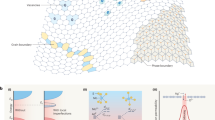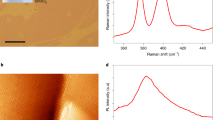Abstract
Continued progress in high-speed computing depends on breakthroughs in both materials synthesis and device architectures1,2,3,4. The performance of logic and memory can be enhanced significantly by introducing a memristor5,6, a two-terminal device with internal resistance that depends on the history of the external bias voltage5,6,7. State-of-the-art memristors, based on metal–insulator–metal (MIM) structures with insulating oxides, such as TiO2, are limited by a lack of control over the filament formation and external control of the switching voltage3,4,6,8,9. Here, we report a class of memristors based on grain boundaries (GBs) in single-layer MoS2 devices10,11,12. Specifically, the resistance of GBs emerging from contacts can be easily and repeatedly modulated, with switching ratios up to ∼103 and a dynamic negative differential resistance (NDR). Furthermore, the atomically thin nature of MoS2 enables tuning of the set voltage by a third gate terminal in a field-effect geometry, which provides new functionality that is not observed in other known memristive devices.
This is a preview of subscription content, access via your institution
Access options
Subscribe to this journal
Receive 12 print issues and online access
$259.00 per year
only $21.58 per issue
Buy this article
- Purchase on Springer Link
- Instant access to full article PDF
Prices may be subject to local taxes which are calculated during checkout




Similar content being viewed by others
References
Linn, E., Rosezin, R., Kügeler, C. & Waser, R. Complementary resistive switches for passive nanocrossbar memories. Nature Mater. 9, 403–406 (2010).
Theis, T. N. & Solomon, P. M. In quest of the next switch: prospects for greatly reduced power dissipation in a successor to the silicon field-effect transistor. Proc. IEEE 98, 2005–2014 (2010).
Waser, R. & Aono, M. Nanoionics-based resistive switching memories. Nature Mater. 6, 833–840 (2007).
Yang, J. J., Strukov, D. B. & Stewart, D. R. Memristive devices for computing. Nature Nanotech. 8, 13–24 (2013).
Chua, L. Memristor—the missing circuit element. IEEE Trans. Circuit Theory 18, 507–519 (1971).
Strukov, D. B., Snider, G. S., Stewart, D. R. & Williams, R. S. The missing memristor found. Nature 453, 80–83 (2008).
Chua, L. Resistance switching memories are memristors. Appl. Phys. A 102, 765–783 (2011).
Borghetti, J. et al. ‘Memristive’ switches enable ‘stateful’ logic operations via material implication. Nature 464, 873–876 (2010).
Yang, J. J. et al. Memristive switching mechanism for metal/oxide/metal nanodevices. Nature Nanotech. 3, 429–433 (2008).
Jariwala, D., Sangwan, V. K., Lauhon, L. J., Marks, T. J. & Hersam, M. C. Emerging device applications for semiconducting two-dimensional transition metal dichalcogenides. ACS Nano 8, 1102–1120 (2014).
van der Zande, A. M. et al. Grains and grain boundaries in highly crystalline monolayer molybdenum disulphide. Nature Mater. 12, 554–561 (2013).
Radisavljevic, B., Radenovic, A., Brivio, J., Giacometti, V. & Kis, A. Single-layer MoS2 transistors. Nature Nanotech. 6, 147–150 (2011).
Pickett, M. D., Borghetti, J., Yang, J. J., Medeiros-Ribeiro, G. & Williams, R. S. Coexistence of memristance and negative differential resistance in a nanoscale metal–oxide–metal system. Adv. Mater. 23, 1730–1733 (2011).
Xia, Y., He, W., Chen, L., Meng, X. & Liu, Z. Field-induced resistive switching based on space-charge-limited current. Appl. Phys. Lett. 90, 022907 (2007).
Ghatak, S. & Ghosh, A. Observation of trap-assisted space charge limited conductivity in short channel MoS2 transistor. Appl. Phys. Lett. 103, 122103 (2013).
Azizi, A. et al. Dislocation motion and grain boundary migration in two-dimensional tungsten disulphide. Nature Commun. 5, 4867 (2014).
Najmaei, S. et al. Vapour phase growth and grain boundary structure of molybdenum disulphide atomic layers. Nature Mater. 12, 754–759 (2013).
Chen, M. et al. Multibit data storage states formed in plasma-treated MoS2 transistors. ACS Nano 8, 4023–4032 (2014).
Kim, I. S. et al. Influence of stoichiometry on the optical and electrical properties of chemical vapor deposition derived MoS2 . ACS Nano 8, 10551–10558 (2014).
Nan, H. et al. Strong photoluminescence enhancement of MoS2 through defect engineering and oxygen bonding. ACS Nano 5738–5745 (2014).
Shen, X., Puzyrev, Y. S. & Pantelides, S. T. Vacancy breathing by grain boundaries—a mechanism of memristive switching in polycrystalline oxides. MRS Commun. 3, 167–170 (2013).
Kim, S., Choi, S. & Lu, W. Comprehensive physical model of dynamic resistive switching in an oxide memristor. ACS Nano 8, 2369–2376 (2014).
Jariwala, D. et al. Band-like transport in high mobility unencapsulated single-layer MoS2 transistors. Appl. Phys. Lett. 102, 173107 (2013).
Najmaei, S. et al. Electrical transport properties of polycrystalline monolayer molybdenum disulfide. ACS Nano 8, 7930–7937 (2014).
Chang, S. et al. Occurrence of both unipolar memory and threshold resistance switching in a NiO film. Phys. Rev. Lett. 102, 026801 (2009).
Yang, Y., Sheridan, P. & Lu, W. Complementary resistive switching in tantalum oxide-based resistive memory devices. Appl. Phys. Lett. 100, 203112 (2012).
Park, J-W. et al. Resistive switching characteristics and set-voltage dependence of low-resistance state in sputter-deposited SrZrO3:Cr memory films. J. Appl. Phys. 99, 124102 (2006).
Aoki, Y. et al. Bulk mixed ion electron conduction in amorphous gallium oxide causes memristive behaviour. Nature Commun. 5, 3473 (2014).
Likharev, K. K. Hybrid CMOS/nanoelectronic circuits: opportunities and challenges. J. Nanoelectron. Optoelectron. 3, 203–230 (2008).
Linn, E., Rosezin, R., Tappertzhofen, S., Böttger, U. & Waser, R. Beyond von Neumann—logic operations in passive crossbar arrays alongside memory operations. Nanotechnology 23, 305205 (2012).
Snider, G. S. Self-organized computation with unreliable, memristive nanodevices. Nanotechnology 18, 365202 (2007).
Xia, Q. et al. Memristor−CMOS hybrid integrated circuits for reconfigurable logic. Nano Lett. 9, 3640–3645 (2009).
Sangwan, V. K. et al. Low-frequency electronic noise in single-layer MoS2 transistors. Nano Lett. 13, 4351–4355 (2013).
Acknowledgements
This research was supported by the Materials Research Science and Engineering Center (MRSEC) of Northwestern University (NSF DMR-1121262) and the Office of Naval Research (N00014-14-1-0669). This work made use of the Electron Probe Instrumentation Center facility (Northwestern University Atomic and Nanoscale Characterization Experimental Center, Northwestern University), which has received support from the MRSEC (NSF DMR-1121262), Nanoscale Science and Engineering Center (NSF EEC-0118025/003), State of Illinois and Northwestern University.
Author information
Authors and Affiliations
Contributions
V.K.S., T.J.M., L.J.L. and M.C.H. designed the experiments. V.K.S. and D.J. fabricated and measured the devices. I.S.K. performed the CVD, photoluminescence and Raman microscopy. V.K.S. and K-S.C. conducted the scanning probe microscopy (AFM/EFM) measurements. All authors wrote the manuscript and discussed the results at all stages.
Corresponding authors
Ethics declarations
Competing interests
The authors declare no competing financial interests.
Supplementary information
Supplementary information
Supplementary information (PDF 11539 kb)
Rights and permissions
About this article
Cite this article
Sangwan, V., Jariwala, D., Kim, I. et al. Gate-tunable memristive phenomena mediated by grain boundaries in single-layer MoS2. Nature Nanotech 10, 403–406 (2015). https://doi.org/10.1038/nnano.2015.56
Received:
Accepted:
Published:
Issue Date:
DOI: https://doi.org/10.1038/nnano.2015.56
This article is cited by
-
Recent progress in the role of grain boundaries in two-dimensional transition metal dichalcogenides studied using scanning tunneling microscopy/spectroscopy
Applied Microscopy (2023)
-
A large-scale integrated vector–matrix multiplication processor based on monolayer molybdenum disulfide memories
Nature Electronics (2023)
-
Imperfection-enabled memristive switching in van der Waals materials
Nature Electronics (2023)
-
0D van der Waals interfacial ferroelectricity
Nature Communications (2023)
-
Vapour-phase deposition of two-dimensional layered chalcogenides
Nature Reviews Materials (2023)



